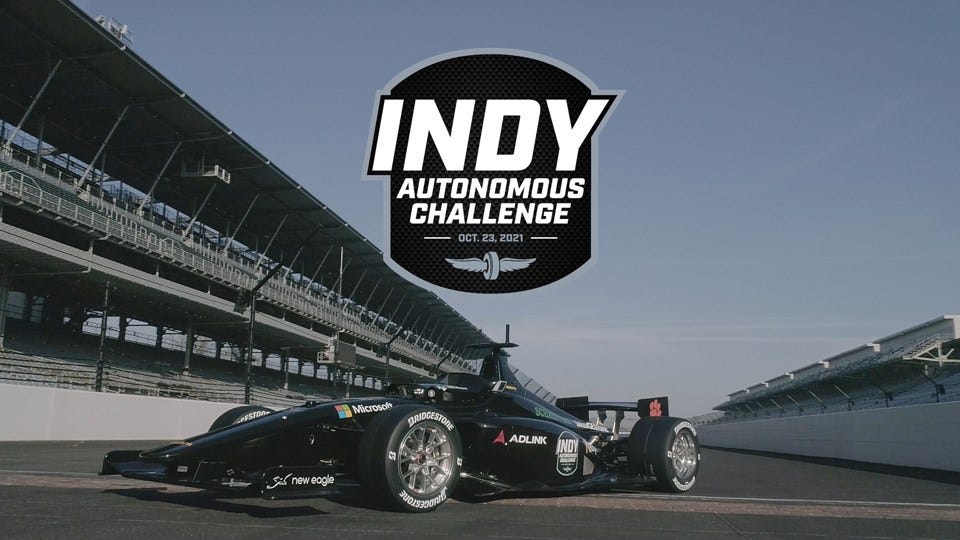Autonomous Race Car Unveiled for Indy Challenge
 ENS and IMS unveiled the Dallara-designed car for the Indy Autonomous Challenge.
ENS and IMS unveiled the Dallara-designed car for the Indy Autonomous Challenge.
Subscriber Benefit
As a subscriber you can listen to articles at work, in the car, or while you work out. Subscribe NowOrganizers of the Indy Autonomous Challenge have unveiled the official racecar that will be driven remotely by dozens of university teams when they compete head-to-head at the Indianapolis Motor Speedway in October.
Indianapolis-based Energy Systems Network and IMS helped to unveil the open-wheel Indy car designed and built by Italian manufacturer Dallara, whose U.S. headquarters is in Speedway.
While it looks like a traditional Indy car, there is no cockpit for a driver and the machine is packed with high-tech sensors, radar, optical cameras and advanced computing.
“The Dallara-built IAC racecar is the most advanced, fastest autonomous vehicle ever developed,” said Paul Mitchell, president and chief executive officer of ESN, and co-organizer of the IAC.
Each car is valued at more than $1 million and is specifically retrofitted for the IAC. Since 2002, Dallara has been the sole racecar supplier of the Indy Lights series.
“We know how the world’s best racecar drivers react in the Dallara, in high-speed scenarios, but now we have to anticipate the actions of a robot,” said Stefano dePonti, CEO and general manager of Dallara USA.
When the autonomous cars race at the famed track on October 23, they will be reaching speeds of 180 miles an hour. They will take 20 laps on the 2.5-mile oval.
Organizers expect as many as 15 cars could be on the track at the same time, but that number is not firm.
Mark Miles, president and CEO of Penske Entertainment Corp., which owns IMS, says the high-speed maneuvering technology being developed for the IAC is not about trying to remove drivers from race cars. But it could make races safer in the years ahead.
“I think about Indy cars, which are already going so fast, and they can go faster, really, it’s safety. That’s the rate limiting factor for the speeds that we have on track today,” said Miles. “And if out of all this, we can find ways to thrill more fans by going faster and having the technology to make that more safe. That’s a home run for us potentially in the future.
The goal of the IAC is to advance the commercialization of fully autonomous vehicles beyond the racetrack.
“We’re not walking away from the Indianapolis 500 and the importance of racecar drivers in those competitions,” said IMS President Doug Boles. “This is about technology that’s going to help us be on the racetrack, but not take away from that element that we love so much on Memorial Day Sunday here is rooting on that driver behind the wheel to win the Indy 500
Boles says track founder Carl Fisher would be thrilled to see this technology accelerate on the famed raceway.
“Carl Fisher would be excited to know that his dream of creating a facility that was designed to test new technologies to make us smarter and make us provide better products to the population safer products to the population,” said Boles. “I think he’d be really excited to know that 111 years later, we’re doing exactly what he was wanting to do in 1909.”
ENS says 30 university teams, representing 11 countries and four continents are competing. In the U.S. 14 states are represented, including teams represented by Purdue University and IUPUI.
Before the October race, there will be test trials at the track this spring and summer, including a qualifying run. Not all 30 teams will make the main race.
The total IAC prize purse is $1.5 million.
ENS and IMS say at this point in the nation’s response to the pandemic, it is too early to announce if race fans will be allowed to watch the IAC in person in October.
IMS President Doug Boles said the technological challenge reflects the history of the track.
ESN President and CEO Paul Mitchell explained how the IAC came to fruition.
